| Draa River fleuve du Draa (French) Río Draa (Spanish) | |
|---|---|
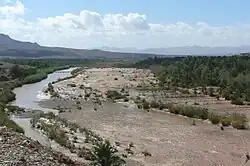 | |
.png.webp) | |
| Native name |
|
| Location | |
| Countries | |
| Physical characteristics | |
| Source | Dadès River |
| 2nd source | Imini River |
| Mouth | Atlantic |
| Length | 1100km |
| Basin features | |
| Progression | Southeast |
| Official name | Embouchure de l'oued Dr'a |
| Designated | 15 January 2005 |
| Reference no. | 1477[1] |
| Official name | Moyenne Dr'a |
| Designated | 15 January 2005 |
| Reference no. | 1482[2] |
- Dra is also the abbreviation for the constellation Draco.
The Draa (Berber languages: Asif en Dra, ⴰⵙⵉⴼ ⴻⵏ ⴷⵔⴰ, Moroccan Arabic: واد درعة, romanized: wad dərʿa; also spelled Dra or Drâa, in older sources mostly Darha or Dara) is Morocco's longest river, at 1,100 kilometres (680 mi). It is formed by the confluence of the Dadès River and Imini River. It flows from the High Atlas mountains, initially south-eastward to Tagounite, and from Tagounite mostly westwards to its mouth in the Atlantic Ocean somewhat north of Tan-Tan. In 1971, the (El) Mansour Eddahabi dam was constructed to service the regional capital of Ouarzazate and to regulate the flow of the Draa. Most of the year the part of the Draa after Tagounite falls dry.
In the first half of the 20th century, the lowest course of the Draa marked the boundary between the French protectorate of Morocco and the area under Spanish rule.
The valley contains the Fezouata formations, which are Burgess shale-type deposits dating to the Lower Ordovician, filling an important preservational window between the common Cambrian lagerstätten and the Late Ordovician Soom shale.[3] In the fossilized fauna were numerous organisms previously thought to have died out after the mid-Cambrian.[4]
History
Prehistory
From all main periods of the prehistory of the Sahara rock-engravings and rock-paintings have been found. Foum Chenna (Tinzouline), Aït Ouaazik (Asguine Tarna, Tazzarine), and Tiouririne e Tisguinine (Zagora) are amongst the best known sites in the Draa region.
Before 1054

The Draa River was also well known to the ancient Romans. It figures on the first world map in history made by Ptolemy (90-168 AD).
Almoravids

Saadi
Alaouites
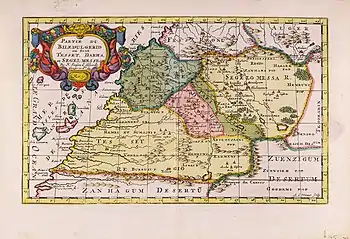
20th century
Kasbahs
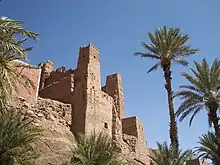
The valley of the Draa has numerous kasbahs.
Agriculture
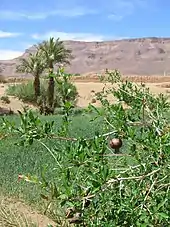
Language
Two languages are spoken in the area: a local variety of Colloquial Arabic which is closely related to Hassaniya, and Shilha or Tashelhiyt, a Berber language.
Oases
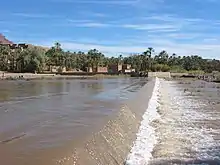
The Upper Draa River valley, about 200 kilometres (120 mi) long, consists of six stretches of oases/palm groves from north to south:
- The Mezguita oasis, with the Agdz and Auriz and south of it the Tamsikht dam
- The oasis of Tinzouline, with Ouled Lagraier, Tinzouline, Ouled Yaoub and a dam south of it
- The Ternata oasis with Zagora
- The Fezouata oasis with Tamegroute and south of it the Azagha dam
- The Ktaoua oasis (English Ktawa) with Tagounite, Blida, Tiraf and the Bounou dam south of it
- The oasis of Mhamid el Ghuzlan with Mhamid el Ghuzlan
Ksour
in the Mezguita
|
|
|
in Tinzouline
|
|
|
in Ternata
|
|
|
in the Fezouata
|
|
|
in the Ktaoua/Ktwawa
This is the southern stretch of the valley between the Azagha and the Bounou dam near Tagounite. There are 55 villages, mostly consisting of ksour (plural of ksar):
|
|
|
Source : Recensement général du Maroc, 1994 (Recensement général de la population et de l'habitat (RGPH, Haut-Commissariat au Plan du Royaume du Maroc (HCP), septembre 1994)).
Exploration
The Draa has attracted the attention of a number of notable explorers including Frenchman Charles de Foucauld who travelled throughout Morocco disguised as a Jewish merchant in the 1800s, Jeffrey Tayler who wrote a book about his experiences and most recently Scottish Adventurer, Alice Morrison, who became the first woman to walk the entire length of the Draa in 2019.
Notes
- ↑ "Embouchure de l'oued Dr'a". Ramsar Sites Information Service. Retrieved 25 April 2018.
- ↑ "Moyenne Dr'a". Ramsar Sites Information Service. Retrieved 25 April 2018.
- ↑ Van Roy, P.; Orr, P. J.; Botting, J. P.; Muir, L. A.; Vinther, J.; Lefebvre, B.; Hariri, K. E.; Briggs, D. E. G. (2010). "Ordovician faunas of Burgess Shale type". Nature. 465 (7295): 215–8. Bibcode:2010Natur.465..215V. doi:10.1038/nature09038. PMID 20463737. S2CID 4313285.
- ↑ Gill, Victoria (13 May 2010). "BBC News - Fossil find resolves ancient extinction mystery". BBC Online. British Broadcasting Corporation. Retrieved 2 September 2015.
- ↑ The topography of Hanno's journey has recently been discussed by W.F.G. Lacroix in the fourth appendix of his Africa in Antiquity. A linguistic and toponymic analysis of Ptolemy's map of Africa (1998 Saarbrücken)
- ↑ A legendary history of the Jews in the Draa valley in the early middle ages can be found in: The Chott el-Maghzen, contributions to oral history collected by rabbi Jacob Moïse Toledano of Tibériade in 1910 and in the Manuscrit of Tiilite (Dadès), in the possession of the rabbi of Tiite Abraham Cohen in 1900. For a summary of that legendary history see D. Jacques Meunié « Le Maroc Saharien des origines au XVIe siècle » Librairie Klincksieck, 1982, pp 175-187. see also: Les tribus oubliées d'Israel - L'Afrique Judeo-Berbere, des origines aux Almohades by Didier Nebot
- ↑ Allain (Ch) & Meunie (J.), La fortress almoravide de Zagora, Hespéris, 1956, vol. xliii, fasc. 2, pp. 305-325.
- ↑ Saadian funerary stele (A.D.1580) (cf. the steles of the Saadian Tombs in Marrakech) with Arabic inscription: 'This is the tomb of (..) Fatima (..) the wife of Caid Abdallah of Tamdart'. Tamdart refers to Tagmadert of the Draa valley. Also inscribed on the stele are the Quaranic verses 26 and 27 of Sura 55.
- ↑ Example of a golden Saadian dinar. This coin, struck by Moulay Zidan (AD 1603–27), was made at the time of the reign of the son of Ahmad al-Mansur. (Numismatic Museum of the al-Maghrib Bank, Rabat, Morocco):
- ↑ Four of the sons of Ismail Ibn Sharif have been khalifa of the Draa:
- Mulay Muhammad as-Sharif bin Ismail as-Samin (s/o full-brother of Muhammad al-Alam). Khalifa of the Draa 1703.
- Mulay 'Abdu'l-Malik bin Ismail as-Samin. b. ca. 1677. Khalifa of the Draa. He was k. for plotting against his father, 1696.
- Mulay Nasir bin Ismail as-Samin. Khalifa of Draa 1702-1703, and of Tafilalt. Rebelled in 1711-1712. He was k. 1714.
- H.M. Sultan 'Abu Marwan Mulay 'Abdu'l Malik, Sultan of Morocco, etc. b. at Meknes, after 1696, son of H.M. Sultan 'Abul Nasir Mulay Ismail as-Samin bin Sharif, Sultan of Morocco, educ. privately. Khalifa of the Draa 1701-1703, and of Sus 1717-1718. Proclaimed Sultan on the deposition of his elder half-brother 13 March 1728. Deposed at Meknes 18 July 1728. Fled to Fez and arrested there 23 December 1728. He was k. (executed) at Meknes, 2 March 1729 (bur. there at the Mulay Ismail Mausoleum).
Bibliography
- Bahani, A., La nouba d'eau et son évolution dans les palmeraies du Draa Moyen du Maroc: CERES. Les oasis du Maghreb, Tunis: pp. 107–126, 1994
- Philip Curtin (ed.), African History, London: Longman, 1988
- M. Elfasi (ed.), General History of Africa III, Africa from the Seventh to the 11th century, UNESCO, 1988
- Charles de Foucauld, Reconnaissance au Maroc, 1888, 1 vol. in -4 and atlas
- Hammoudi, A., Substance and Relation: Water Rights and Water Distribution in the Dra Valley. In: Mayer, A.E. (Ed.), Property, Social Structure, and law in the Modern Middle East. New York: pp. 27–57, 1985
- Marmol Caravajal, Africa, 1667 3 vol. in 4
- Thomas Pellow; Josephine Grieder, The History of the long captivity and adventures of Thomas Pellow, in South-Barbary : [written by himself], 1973 (repr.of the 1739 edition with a new introd. for the Garland ed. by Josephine Grieder) ISBN 0-8240-0583-X
- W.D. Seiwert (ed.), Maurische Chronik, München: Trickster Verlag, 1988
- Jacques-Meunié, D., Le Maroc Saharien, des origines à 1670. Thèse d'État. 2 tomes, Librairie Klincksieck, Paris, 1982
- G. Spillmann, Villes et Tribus du Maroc vol. IX, Tribus Berbères Tome II, Districts et Tribus de la Haute Vallée du Dra, Paris, 1931
- Jeffrey Tayler, Valley of the Casbahs, 2004
- Ahmed Zainabi, La Vallée du Dra: Développement Alternatif et Action Communautaire, 2001 (Background paper WDR 2003)
External links
- Michel, J. (1995). The Invasion of Morocco in 1591... University of Pennsylvania - African Studies Center.